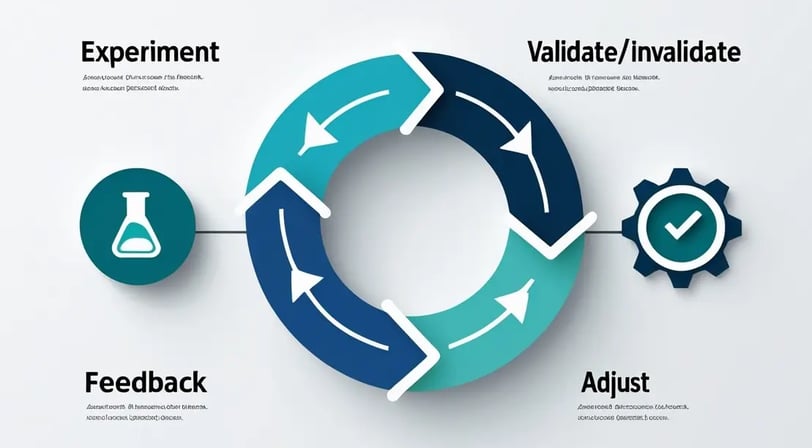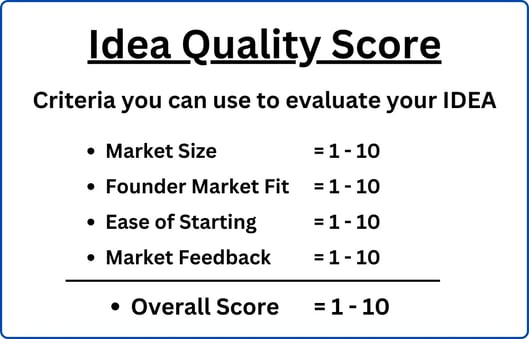
All About Pivoting a Startup Idea
Learn when and how to pivot your Startup effectively. This comprehensive guide covers pivot timing and strategies to find better opportunities for your business
Fabio Silva
1/23/202514 min read
Introduction
Every entrepreneur dreams of achieving success with their first startup idea, but the reality is often different. Studies show that 92% of successful startups end up pivoting from their original concept. Yet, many founders struggle with when and how to make this crucial decision. Whether you're wrestling with disappointing traction or feeling stuck in a direction that doesn't excite you anymore, understanding the art of pivoting can be the difference between success and failure.
In this comprehensive guide, we'll explore everything from recognizing pivot signals to evaluating new opportunities. Let's break down the key principles that will help you pivot with confidence and turn challenges into opportunities.


AI Gen Discussion about this Blog:
Share this Blog:

1. Understanding Pivot in Startups
A. Definition and Types of Pivots
While "pivot" has become somewhat of a buzzword in startup circles, its core meaning is surprisingly straightforward: it's simply changing your business idea. However, understanding the nuances of what constitutes a true pivot versus a minor adjustment is crucial for entrepreneurs.
A “true pivot” typically involves a more substantial transformation, often occurring when an established company with existing users, employees, and funding decides to shut down its current operations to pursue a different direction. One of the most famous examples is Slack, which began as a gaming company called Glitch with over 100 employees before completely changing course to become the communication platform we know today.
However, in the early stages of a startup, changes don't need to be this dramatic to be considered pivots. These early-stage modifications can range from targeting a different customer segment to completely redesigning the product offering. The key is understanding that any significant change in your business model or strategy can be considered a pivot, regardless of scale.
B. Lightweight Nature of Early-Stage Pivots
For pre-launch or newly launched startups, pivoting should feel like a natural and lightweight process. In fact, if you're not regularly adjusting and changing your ideas during these early stages, you might be doing something wrong. This constant evolution is not just normal – it's essential for finding the right version of your business idea.
The lightweight nature of early pivots serves several purposes:
- It allows for rapid experimentation;
- It helps validate or invalidate assumptions quickly;
- It enables founders to respond to market feedback efficiently;
- It prevents the accumulation of technical or operational debt.
Early-stage entrepreneurs should embrace this flexibility and view pivoting as an iterative process rather than a dramatic, one-time event. The ability to change direction quickly and efficiently is one of the key advantages that startups have over larger companies.
C. The Opportunity Cost Factor
Perhaps the most compelling reason to consider pivoting is opportunity cost – the potential gains you're missing out on by continuing to pursue your current path. This concept can be expressed through a simple formula:
(Current Progress / Months of Effort) < (Excitement for New Direction + Confidence in Success)
When evaluating whether to pivot, entrepreneurs should consider not just what they're currently doing, but what they could be doing instead. This involves analyzing:
1. Current trajectory and progress
2. Time and resources invested
3. Potential alternative opportunities
4. Likelihood of success in new directions
The opportunity cost becomes particularly significant when you consider that startups operate with limited resources – especially time and money. Every month spent pursuing an idea that isn't gaining traction is a month you could have spent building something with greater potential for success.
Understanding opportunity cost helps founders make more objective decisions about pivoting. Instead of viewing a pivot as a failure, it should be seen as a strategic reallocation of resources toward more promising opportunities. This perspective shift is crucial for maintaining agility and maximizing the chances of success in the startup journey.
Remember that the goal isn't to pivot at the first sign of difficulty, but rather to maintain enough flexibility and self-awareness to recognize when a change in direction might be the best strategic move. This balance between persistence and adaptability is what often separates successful startups from those that fail to gain traction.
The key is to develop a mindset that views pivoting as a normal, necessary part of the startup process rather than a last-resort option. This understanding, combined with a clear grasp of opportunity costs, enables founders to make better-informed decisions about when and how to pivot their businesses.
2. Reasons for Pivoting
Understanding when to pivot is crucial for startup success. Let's explore both valid and invalid reasons that might lead founders to consider changing their direction.
A. Valid Reasons to Pivot
a. Lack of Growth and Progress
One of the most compelling reasons to pivot is when your startup simply isn't growing. If you've been working on your idea for months and the key metrics aren't showing meaningful progress, it's time to seriously consider a change. This can be evaluated using a simple formula: if your current progress divided by months of dedicated work is less than your combined enthusiasm and confidence in new opportunities, pivoting might be the right choice.
b. Personal Fit Issues
Sometimes, the deeper you get into building your startup, the more you realize you're not the right person to execute the idea. This misalignment can manifest in several ways: you might find yourself consistently dreading the work, or discover that your skill set and experience don't align with what the business truly needs to succeed. It's crucial to be honest with yourself about these personal fit issues, as they can significantly impact your startup's potential for success.
c. External Dependencies
A critical red flag is when your startup's success relies heavily on external factors outside your control. For example, if your business model depends on mainstream virtual reality headset adoption or widespread cryptocurrency acceptance, you're essentially betting on factors you can't influence. Waiting for external market conditions to align perfectly is often a recipe for stagnation. Your startup's success should primarily depend on factors within your control.
d. Exhaustion of Ideas
When you've exhausted all possible solutions to make your current idea work, it's a strong indicator that pivoting might be necessary. If you've tried multiple approaches, implemented various strategies, and still can't find traction, it might be time to explore new directions. This exhaustion of ideas often signals that the fundamental premise of your startup might need reconsideration.
B. Invalid Reasons to Pivot
a. Avoiding Hard Work
One of the most common yet inappropriate reasons for pivoting is attempting to avoid challenging aspects of building a business. For instance, some founders repeatedly pivot right when it's time to start selling their product. This pattern of avoiding sales work or other difficult tasks by constantly switching ideas is a red flag. Remember, every business model will have its challenges, and running away from them won't lead to success.
b. Chronic Idea Changes
Some entrepreneurs have a habit of constantly changing their ideas before giving any single concept a fair chance to succeed. This chronic pivoting can be just as dangerous as staying too long with a failing idea. If you recognize this pattern in yourself, it might be better to commit to seeing one idea through to completion, even if just to break this harmful cycle and learn valuable lessons about persistence and execution.


c. Following Trends
Pivoting solely because you read about a hot new trend in TechCrunch or heard about another startup raising significant funding is not a valid reason to change direction. These external motivations often lead to poor decision-making and can result in pursuing opportunities that don't align with your strengths or genuine interests. Your pivot should be driven by concrete evidence and personal conviction, not by FOMO or market hype.
The key to making good pivoting decisions lies in being honest with yourself about your motivations. Are you changing direction because of genuine, data-backed reasons, or are you simply trying to avoid challenges or chase the next shiny object? Understanding the difference between valid and invalid reasons for pivoting can help you make more strategic decisions about your startup's future.
Remember, while pivoting is a natural part of the startup journey, it should be done thoughtfully and for the right reasons. The goal is to find a sustainable path to success, not to avoid difficulties or chase temporary trends.


b. Fear of Admitting Defeat
Many entrepreneurs struggle with the perception that pivoting equals failure. This fear of admitting defeat can be particularly challenging in startup culture, where persistence and "never giving up" are often celebrated virtues. However, this mindset can be counterproductive when it prevents necessary strategic changes. It's important to recognize that pivoting is not admitting defeat but rather demonstrating the wisdom to adapt and evolve.
c. External Blame Attribution
A common psychological defense mechanism is the tendency to blame external factors for a startup's lack of success. Founders might convince themselves that their idea is "ahead of its time" or that the market "just doesn't get it yet." This external blame attribution can be dangerous because it prevents honest self-reflection and delays necessary pivots. When founders spend more time justifying why things aren't working rather than adapting to market realities, it's often a sign that they're falling into this trap.
B. The Traction Trap
a. Misinterpreting Politeness
One of the most insidious challenges founders face is misinterpreting politeness for genuine interest. People are naturally inclined to be polite and may offer encouraging feedback even when they have no real intention of using or purchasing a product. Comments like "This is interesting" or "Maybe if you add these features, we'll take another look" can be particularly misleading. Founders need to learn to distinguish between polite responses and actual market validation, focusing on concrete actions rather than verbal encouragement.
b. Small Success Complications
Perhaps counterintuitively, having modest traction can sometimes be more challenging than having none at all. When a startup achieves small successes - a handful of customers, some revenue, or limited user growth - it can create a dangerous middle ground that keeps founders trapped in a state of perpetual hope without significant progress.
This "small success trap" is particularly dangerous because:
It provides just enough validation to keep founders invested
It makes the decision to pivot more complex than with a complete failure
It can consume resources and energy that might be better spent exploring new directions
The irony is that founders who experience complete failure often have an advantage - they can more easily make a clean break and pivot to new opportunities without the baggage of minimal success holding them back.
To overcome these challenges, founders should:
Set clear metrics and timelines for evaluating progress
Seek honest, quantifiable feedback rather than relying on polite encouragement
Regularly assess whether current traction justifies continued investment
Remember that pivoting is a normal part of the startup journey, not a sign of failure
Understanding these common pivot delays and challenges is crucial for entrepreneurs. By recognizing these patterns early, founders can make more objective decisions about when to persist and when to pivot, ultimately increasing their chances of finding a successful path forward.
3. Pivot Delays and Challenges
Most founders tend to take too long to pivot, often holding onto struggling ideas well past their expiration date. Understanding these common delays and challenges can help entrepreneurs make more timely and objective decisions about their startup's direction.
A. Psychological Barriers
a. Loss Aversion
One of the most powerful psychological barriers preventing timely pivots is loss aversion - the human tendency to strongly prefer avoiding losses over acquiring equivalent gains. When founders invest significant time, money, and emotional energy into their startup, letting go becomes increasingly difficult. This psychological attachment can cloud judgment and lead to prolonged commitment to failing ideas, even when evidence suggests a change is necessary.
4. Timing and Decision Making
A. Optimal Pivot Timing
Knowing when to pivot is one of the most crucial decisions a startup founder will face. The best time to pivot typically presents itself through clear signals that shouldn't be ignored. According to experienced entrepreneurs, the optimal time to pivot is as soon as certain key indicators become apparent:
When you've been trying to gain users for weeks or months without success, and the situation feels genuinely hopeless
When you recognize that your current idea requires unrealistic amounts of time or capital to get started
When you know deep down that the current direction isn't going to work, despite maintaining a positive external appearance
It's particularly important to note that your intuition as a founder often serves as a reliable compass. If you find yourself unable to convince yourself of your startup's potential, it's likely time to consider a pivot. After all, you possess the most intimate knowledge of your business, and while the truth might be uncomfortable, it's essential to listen to these internal signals.
B. Product Market Fit Considerations
Product-market fit remains one of the most critical factors in determining whether to persist with an idea or pivot. It's a concept that's frequently discussed but often misunderstood. The reality is that most startups never achieve true product-market fit, and many founders mistakenly believe they have it when they don't.
The clearest indicator of product-market fit is when growth is no longer your primary challenge. When you've achieved genuine product-market fit, you'll find yourself dealing with other operational challenges rather than constantly struggling to attract and retain users or customers.
This understanding of product-market fit should directly influence your pivot decisions. If you're consistently struggling to gain traction and see no clear path to achieving product-market fit, it might be time to consider a pivot. Remember that the absence of product-market fit isn't necessarily a reflection of your capabilities as a founder, but rather an indication that your current solution might not be optimally aligned with market needs.
C. Multiple Attempts Strategy
One of the most powerful perspectives on pivoting is viewing it through the lens of "shots on goal." This strategy suggests that having multiple attempts at finding the right idea significantly increases your chances of success. Rather than viewing a pivot as a failure, consider it as another opportunity to take a shot at achieving product-market fit.
The multiple attempts strategy works particularly well when each attempt is:
Well-executed and thoughtful
Completed through to proper market testing
Given enough time to prove itself, but not so much that it drains resources
Followed by careful analysis and learning
This approach creates what might be called "engineered luck." By taking several high-quality shots at different ideas, you mathematically increase your chances of finding success compared to founders who stubbornly stick with their first idea. However, it's crucial to note that these attempts must be high-quality pivots - not just jumping from one half-baked idea to another.


The key to executing this strategy effectively is maintaining a balance between persistence and flexibility. Each attempt should involve:
Building a complete product
Shipping it to users
Following best practices for validation
Making an informed decision about whether to continue or pivot
This approach is particularly powerful because it combines the benefits of thorough execution with the advantages of multiple opportunities. It's much easier to get lucky when you have several well-executed attempts rather than putting all your eggs in one basket.
Remember that each pivot should be treated as a learning opportunity, with insights from previous attempts informing future directions. This iterative process, when done correctly, can significantly increase your chances of eventually finding the right idea that achieves product-market fit and leads to sustainable growth.
5. Finding Better Startup Ideas
After deciding to pivot, the crucial next step is identifying a better direction for your startup. This process requires careful consideration of multiple factors to increase your chances of success. Let's explore the key elements that should guide your search for a new idea.
A. Key Considerations
a. Personal Excitement and Motivation
One of the most fundamental aspects of choosing a new direction is finding something that genuinely excites you. Your startup idea should make you optimistic about the future and eager to start each workday. If you're pursuing an idea solely because it's trending in TechCrunch or attracting investor attention, but it doesn't inspire you, it's probably not the right path. Personal passion and genuine interest are crucial drivers for long-term commitment and success.
b. Skills Assessment
Making an honest evaluation of your strengths and weaknesses is critical when selecting a new direction. This self-awareness helps you identify opportunities where you can leverage your expertise while avoiding areas where you might struggle. Founder-market fit is essential - your skills and experience should align with the demands of your chosen venture. Being realistic about your capabilities will help you avoid ideas that might look attractive but are beyond your current skill set.
c. Quick Validation Potential
When pivoting, prioritize ideas that can be validated quickly. Look for opportunities where you can build and test a minimum viable product (MVP) rapidly, rather than concepts requiring years of research and development. Fast iteration and quick feedback cycles are valuable advantages, especially when you're pivoting from a previous idea.
B. Venture Capital Compatibility
While not all startups need venture capital funding, it's important to understand whether your new idea aligns with VC expectations if that's your intended path. A venture-scale business typically demonstrates several key characteristics:
Potential for hundreds of millions or billions in annual revenue
Rapid growth trajectory (typically within 5-10 years)
Possibility of becoming a publicly traded company
Technology as a core component
High gross margins (typically 70-80% for software companies)
Founder-built technology in the early stages
C. Idea Quality Score Framework
To evaluate potential ideas systematically, consider using an Idea Quality Score Framework. This framework assesses four crucial criteria, each rated on a scale of 1-10:


a. Market Size
Evaluate the potential scale of your idea. Consider whether it could become a major publicly traded company or if it's limited to a smaller market. The bigger the potential market, the higher the score in this category.
b. Founder Market Fit
This measures how well your background aligns with the opportunity. A perfect score (10/10) might go to someone starting a self-driving car company after years of experience in that specific field. Conversely, attempting an advanced AI startup without programming knowledge would score very low.
c. Ease of Starting
Consider how quickly and efficiently you can begin working on the idea. Many potentially great ideas fail because founders can't find an effective way to start. The easier it is to get started and begin testing your assumptions, the higher this score should be.
d. Market Feedback
Assess how straightforward it is to get positive market feedback. Ideas that generate immediate interest and enthusiasm from potential customers score higher than those requiring extensive convincing or market education.
The final Idea Quality Score is calculated by averaging these four criteria, providing a quantitative way to compare different opportunities. This framework helps ensure you're considering all crucial aspects of a potential pivot direction while maintaining objectivity in your decision-making process.
Remember that finding a better idea isn't just about identifying an opportunity that looks good on paper. It's about finding the sweet spot where market potential, your capabilities, and practical execution considerations align. Take time to evaluate multiple options through this comprehensive lens before committing to your new direction.
Conclusion: Making Pivots Work for You
Pivoting is an integral part of the startup journey, not a sign of failure. As we've explored throughout this guide, successful pivots require a delicate balance of timing, self-awareness, and strategic thinking. The key is to approach pivoting as a natural evolution of your entrepreneurial journey rather than a last resort.
Remember these essential takeaways:
Early-stage pivots should feel lightweight and natural
Don't let psychological barriers or small successes trap you in a failing direction
Use the Idea Quality Score Framework to evaluate new opportunities objectively
Trust your intuition while backing it with data and market feedback
View each pivot as another "shot on goal" that increases your chances of success
Most importantly, maintain a growth mindset throughout the process. Every pivot, whether it leads to immediate success or not, provides valuable lessons that make you a stronger entrepreneur. The most successful founders aren't necessarily those who got it right the first time, but those who remained adaptable and resilient enough to find the right opportunity through strategic pivots.
As you consider your own startup's direction, use the frameworks and insights shared in this guide to make more informed decisions about when and how to pivot. Remember, it's not about avoiding failure – it's about failing smart and pivoting strategically toward success.
Listen a discussion about this Blog:
Share this Blog:
Useful Links:
Y-Combinator: Accelerator | We help founders make something people want and the results speak for themselves.
How to Get Startup Ideas: Learn how to generate innovative startup ideas, avoid common pitfalls, & find your winning business concept.
How to Build a MVP: Learn how to build a Minimum Viable Product (MVP) with actionable tips, examples, and strategies. Perfect for early-stage entrepreneurs ready to launch fast.
Should You Start a Startup?: Wondering if starting a startup is for you? Explore traits of successful founders, actionable steps, and insights to confidently launch your business venture.
Create a Quick MVP: Validating your idea, launching your MVP, or scaling your Startup, we provide the expertise to help you succeed
Business Model Templates: Templates for Lean Startup.
TechCrunch: Online newspaper focusing on topics regarding high-tech and startup companies.
ProductHunt: Product Hunt surfaces the best new products, every day.
Subscribe to our Blog
Get exclusive access to cutting-edge insights, startup stories, and technological breakthroughs delivered directly to your inbox. Be the first to know about emerging innovations, founder interviews, and deep-dive analyses that shape the future of technology.


Location
Carrer del Llebeig, 3 Balearic Islands
07610 - Spain
Contacts
+34 617 517 230
contact@quickmvp.io
© 2024 QuickMVP. All rights reserved.
Connect
